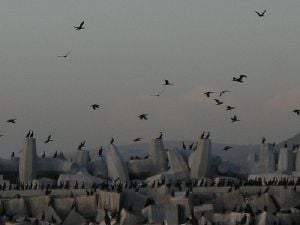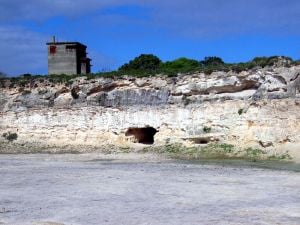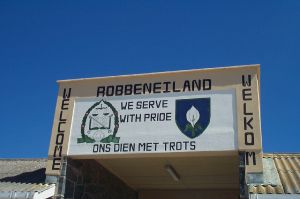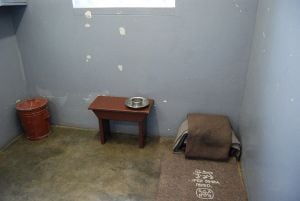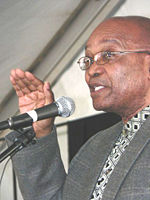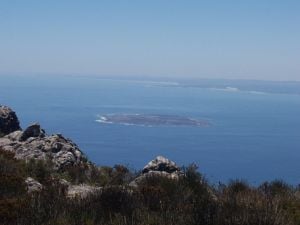Difference between revisions of "Robben Island" - New World Encyclopedia
Mary Anglin (talk | contribs) (fix & submit) |
Mary Anglin (talk | contribs) |
||
| Line 113: | Line 113: | ||
==The island today== | ==The island today== | ||
[[Image:Robben island from table mountain.jpg|thumb||Robben Island as viewed from Table Mountain.]] | [[Image:Robben island from table mountain.jpg|thumb||Robben Island as viewed from Table Mountain.]] | ||
| − | + | Robben Island and its properties are ownded by the government, with the exception of the island church. | |
| − | + | [[UNESCO]] designated Robben Island a cultural [[World Heritage Site]] in 1999, noting that; | |
| + | "The buildings of Robben Island bear eloquent testimony to its sombre history." and | ||
| + | "Robben Island and its prison buildings symbolize the triumph of the human spirit, of freedom, and of democracy over oppression." | ||
| − | + | Today the island is a popular tourist destination, reachable by [[ferry]] from the Victoria & Alfred Waterfront in [[Cape Town]]. Robben Island Museum operates as a site or living museum. Tours of the Island and the prison are led by guides who were formerly prisoners there. | |
| − | The Moturu Kramat, a sacred site for Muslim pilgrimage on Robben Island, was built in 1969 to commemorate [[Sayed Abdurahman Moturu]], the [[Prince of Madura]]. Moturu, one of Cape Town's first | + | Sites on the Island in addition to the prison museum include: |
| + | * The lighthouse on Minto Hill (formerly known as Fire Hill), the highest point on the island. It is where Jan van Riebeeck first set a navigation aid. Huge bonfires were lit at night to warn VOC ships of the rocks which surround the island. The current Robben Island lighthouse, built in 1863, is 60 feet (18 meters) high and was converted to [[electricity]] in 1938. It is the only South African lighthouse to utilize a flashing light instead of a revolving light, which can be seen from 15 miles (25 km) away. | ||
| + | * The Moturu Kramat, a sacred site for [[Muslim]] pilgrimage on Robben Island, was built in 1969 to commemorate [[Sayed Abdurahman Moturu]], the [[Prince of Madura]]. Moturu, one of Cape Town's first imams, was exiled to the island in the mid 1740s and died there in 1754. Muslim political prisoners would pay homage at the shrine before leaving the island. | ||
==Resources== | ==Resources== | ||
Revision as of 01:59, 21 August 2008
| Robben Island* | |
|---|---|
| UNESCO World Heritage Site | |
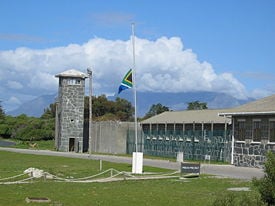
| |
| State Party | |
| Type | Cultural |
| Criteria | iii, vi |
| Reference | 916 |
| Region** | Africa |
| Inscription history | |
| Inscription | 1999 (23rd Session) |
| * Name as inscribed on World Heritage List. ** Region as classified by UNESCO. | |
Robben Island (Afrikaans Robbeneiland) is an island in Table Bay, some seven kilometres off the coast of the Cape Town bay, South Africa and is located at Template:Coor at d. The name is Dutch for "seal island." (Incidentally, "Seal Island" is a different island in nearby False Bay.) Robben Island is roughly oval in shape and about a kilometre wide. It is of particular note as it was here that former South African President and Nobel Laureate Nelson Mandela, alongside many other political prisoners, spent decades imprisoned during the apartheid era.
Geography
Robben Island lies 5 miles (8 km) off the coast of South Africa in Table Bay. Roughly oval shaped, the island is about six-tenths of a mile (one kilometer) in width, with an approximate area of 5 square miles (13 square km). West of the mainland, it is approximately 6 miles (10 km) north of the city of Cape Town.
The name Robben Island comes from the original Dutch name, "Robbe Eiland", meaning "seal island." At the time of European discovery in the late fifteenth century, seals were plentiful, as were penguins, tortoises, birds and sea mammals. Whales surrounded the island in early spring, while lobsters and shellfish were found along the shoreline.
Today there are approximately 132 bird species, including seabirds, waterbirds and terrestrial birds. While some are naturally occurring others, such as the Chukar Partridge and Guinea Fowl were introduced by humans. The Island's environment provides a sheltered haven for this large variety of bird species, some of which are endangered. The crowned cormorant and black crowned night herons, who live principally on the mainland, breed on the Island in large colonies.
There are 23 mammal species that make their home on the Island, including small herds of bontebok, springbok, steenbok, fallow deer and eland. The antelope were introduced around 1960 by the Island's prison warden, who also brought giant tortoises. Ostriches, lizards, geckos, and snakes also live on Robben Island.
The African penguin was abundant in the 17th century but had become extinct on the island in the 1800s through human activities. By 1983 they had been successfully re-introduced and have since established themselves as a breeding population.
The island, the summit of an ancient, now submerged mountain, is flat and low-lying, with the highest point being approximately 80 feet (24 meters) above sea level. The highest point is known as Minto's Hill, and is named after a nineteenth-century Surgeon-Superintendent of the General Infirmary. It is composed of Precambrian metamorphic rocks belonging to the Malmesbury Group. Above this shale is a thick limestone and calcrete deposit covered by windblown sands and shell fragments.
Similar to nearly Cape Town, the climate is Mediterranean, but Robben Island experiences stronger winds and comparative extremes in temperature.
History
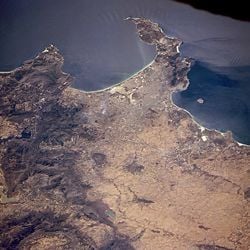
Robben Island was first inhabited thousands of years ago by stone age people, at a time when sea levels were considerably lower than they are today and people could walk to it. Toward the end of the last Ice Age the melting of the ancient ice caps caused sea levels to rise and the land around the island was flooded by the ocean.
Robben Island is believed to have been discovered by Europeans in 1488 when Bartolomeu Dias anchored his ship in Table Bay. For the next century it was used by British and Dutch colonialists and traders as both an outpost and prison. By 1591 many people of the Khoikhoi tribe used the island as refuge from the fast encroaching European settlements on the mainland.
Jan Van Riebeeck, of the Dutch East India Company, arrived on the Cape in 1652 and used the island as a vital refreshment station. Many in the company feared entering the continent, preferring to land on Robben Island to hunt seals, penguins and tortoises. By 1654, Riebeeck had his men live and work on the Island, where they hunted and mined stone. Soon leaders of native resistance to Dutch settlers became prisoners on the Island. The first political prisoner was Autshumato, who was exiled to the Island in 1658. He is one of the few prisoners known to have escaped successfully.
By the late 1600s a new group of prisoners arrived on the Island - political leaders of anti-Dutch governing in the East Indies, many of them former indigenous rulers such as kings, princes, and religious leaders.
In 1795 the British claimed the southern tip of Africa and began using Robben Island as a penal colony. Army deserters, murderers, thieves and political prisoners, and eventually many Xhosa captives, were taken to the Island.
Robben Island gradually evolved into more of a hospital, and by the mid 1800s was populated by the mentally ill, lepers, diseased people and the impoverished. However, there was actually no medical treatment available on the Island and the sick received the same treatment as the prisoners. It had essentially become a dumping ground for those considered undesirable.
Eventually the "lunatics" were separated from the rest of the island population, while blacks and whites were further separated.
In 1892 the lepers organized a protest against the harsh conditions imposed by the British. Additional troops were sent to put an end to the uprising, and the main spokesperson, Franz Jacobs, was forced to recant his allegations of harsh treatment. Within several years the conditions for the lepers improved and they were allowed visitors and mail and the buildings in which they resided were renovated and repaired.
During the 1930s the Island's lepers were sent to hospitals on the mainland and all the building were burned to the ground to prevent the spread of disease. The population of the Island fell from several thousand to a handful of caretakers and lighthouse keepers.
Just prior to World War II, South Africa's military took control of Robben Island. They housed some of the country's most advanced weaponry and built secure roads, an improved water supply system, a new power station, and rows of modern houses. Though it had become a military post, by 1961 it resumed its role as an island penitentiary.
The Apartheid Era
Under the system of apartheid, Robben Island became a maximum security prison, whose character as an island-prison near a major population center invites comparisons with Alcatraz Island.
Between 1961 and 1991, over three thousand men were incarcerated on Robben Island as political prisoners, often for decades, perhaps the most well-known being Nelson Mandela. Prisoner family member visits were restricted to once every six months for a period of only thirty minutes, in conditions which made even conversation difficult. The only reading material allowed was the Bible. A variety of barbaric impositions were made on prisoners, including breaking rocks and mining lime. In the early 1980s, many prisoners engaged in more active demands for rights, and a 1981 hunger strike reinforced their case and led to some minor improvements in conditions.
Throughout this period, security was very tight and the island off limits to almost all civilians, including fishermen. Before about 1980 almost no-one, even among inhabitants of Cape Town, had set foot on the island. It is not generally known that the use of the island as a prison was greatly inhibited for centuries by a lack of fresh water. The island is arid, with low scrubby vegetation and has no watercourses. Boreholes were drilled in the first half of the 20th century but in due course the fragile water table was invaded by sea water and the bores became useless. Sometime after 1965 a pipeline was laid on the bottom of the ocean from Cape Town.
The particular character of the apartheid era prisoners, and their disciplined morale in the face of considerable difficulties and even abuse, is well attested as being sustained by their commitment to the cause of the struggle for freedom, in particular for the majority black African population.
In June 1980 Frederik Willem de Klerk initiated the removal of political prisoners, and most prisoners left by May 1981. The last of the non-political prisoners (who had always been held separately from political prisoners) left the island in 1996, and it became a museum in 1997. Nelson Mandela left to worldwide acclaim on February 11th, 1990.
In 1959 the island became a maximum security prison and between 1961 and 1991 over three thousand men were incarcerated here as political prisoners. The most famous of these was, of course, Nelson Mandela. He describes his time on Robben island in his autobiography, Long Walk to Freedom. June 1990 saw the start of the removal of political prisoners by then-president FW de Klerk, the last leaving the island in May 1991. The last common-law (not political) prisoners, who had always been held separately from political prisoners, left the island in 1996.
Fortifications were erected during World War II, and from the mid-1960s to 1991 Robben Island served as South Africa’s maximum-security prison. Most inmates, including Nelson Mandela, were black men incarcerated for political offenses. The last of these prisoners were released in 1991. The island continued to serve as a medium-security prison for criminal offenders until 1996. In 1997 it was turned into a museum and declared a national monument, and in 1999 it received designation as a
BEST? In 1961 the Prisons Department took over and built an austere maximum-security prison. It was here that Nelson Mandela was sent after receiving a life imprisonment sentence in 1963. Political and common-law prisoners were initially lodged together. Contact with the outside world was limited to receiving and sending two letters a year. In 1971 the political prisoners were further isolated. Beatings, hard physical labour in the lime quarry, prolonged solitary confinement and insufficient food, bedding and clothing were endured for many years. Hunger strikes, legal action and international pressure eventually brought better conditions. The prison even became an informal university behind bars, with prisoners tutoring their warders. 1991 saw the release of the remaining political detainees and in 1996 the common-law prisoners were transferred to the mainland.
List of former prisoners held at Robben Island
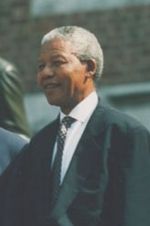
- Autshumato, one of the first freedom fighters against colonialism
- Dennis Brutus, former activist and poet
- Patrick Chamusso, former activist of the ANC
- Laloo Chiba, former accused at Little Rivonia Trial
- Jerry Ekandjo, Namibian politician
- Nceba Faku, current Metro Mayor of Port Elizabeth
- Petrus Iilonga, Namibian trade unionist, freedom fighter and politician
- Ahmed Kathrada, former Rivonia Trialist and long-serving prisoner
- Langalibalele, one of the first freedom fighters against colonialism
- Mosiuoa Lekota, imprisoned in 1974, current Minister of Defence
- Mac Maharaj, former accused at Little Rivonia Trial
- Nelson Mandela, African National Congress leader and former President of South Africa
- Chief Maqoma, former chief who died on the island in 1873
- Jeff Masemola, the first prisoner sentenced to life imprisonment in the apartheid era
- Amos Masondo, current Mayor of Johannesburg
- Govan Mbeki, father of the current President of South Africa, Thabo Mbeki
- Makana,one of the first freedom fighters against colonialism
- Wilton Mkwayi, former accused at Little Rivonia Trial
- Murphy Morobe, Soweto Uprising student leader
- Sayed Adurohman Moturu, the Muslim Iman who was exiled on the island and died there in 1754
- Griffiths Mxenge, a South African Lawyer and member of the African National Congress
- M.D. Naidoo, a South African lawyer and member of the African National Congress
- Nongqawuse, the Xhosa prophet responsible for the Cattle Killing
- Maqana Nxele, former Xhosa prophet who drowned while trying to escape
- John Nyathi Pokela, co-founder and former chairman of the PAC
- Joe Seremane, current chairperson of the Democratic Alliance.
- Tokyo Sexwale, businessman and aspirant leader of the African National Congress
- Walter Sisulu, former ANC struggle hero
- Robert Sobukwe, former leader of the PAC
- Andimba Toivo ya Toivo, Namibian politician
- Jacob Zuma, former Deputy President of South Africa and leader of the ANC
The island today
Robben Island and its properties are ownded by the government, with the exception of the island church.
UNESCO designated Robben Island a cultural World Heritage Site in 1999, noting that; "The buildings of Robben Island bear eloquent testimony to its sombre history." and "Robben Island and its prison buildings symbolize the triumph of the human spirit, of freedom, and of democracy over oppression."
Today the island is a popular tourist destination, reachable by ferry from the Victoria & Alfred Waterfront in Cape Town. Robben Island Museum operates as a site or living museum. Tours of the Island and the prison are led by guides who were formerly prisoners there.
Sites on the Island in addition to the prison museum include:
- The lighthouse on Minto Hill (formerly known as Fire Hill), the highest point on the island. It is where Jan van Riebeeck first set a navigation aid. Huge bonfires were lit at night to warn VOC ships of the rocks which surround the island. The current Robben Island lighthouse, built in 1863, is 60 feet (18 meters) high and was converted to electricity in 1938. It is the only South African lighthouse to utilize a flashing light instead of a revolving light, which can be seen from 15 miles (25 km) away.
- The Moturu Kramat, a sacred site for Muslim pilgrimage on Robben Island, was built in 1969 to commemorate Sayed Abdurahman Moturu, the Prince of Madura. Moturu, one of Cape Town's first imams, was exiled to the island in the mid 1740s and died there in 1754. Muslim political prisoners would pay homage at the shrine before leaving the island.
Resources
- A touch of Mandela. Timeline of Robben Island Retrieved August 20, 2008.
- Buntman, Fran Lisa. 2003. Robben Island and prisoner resistance to apartheid. Cambridge, UK: Cambridge University Press. ISBN 9780521537681
- Encyclopædia Britannica Online. 2008. Robben Island Retrieved August 20, 2008.
- Maharaj, Mac, and Nelson Mandela. 2002. Reflections in prison: voices from the South African liberation struggle. Amherst: University of Massachusetts Press. ISBN 9781558493421
- Mangena, Isaac. March 17, 2008. Robben Island 'a lonely place' News 24.com. Retrieved August 20, 2008.
- Robben Island Museum. Robben Island Museum Retrieved August 20, 2008.
- Zuma, Jacob. June 13, 2001. UWC Mayibuye Robben Island Archives South African Government. Retrieved August 20, 2008.
External links
- Documentary about Apartheid and Robben Island Retrieved August 20, 2008.
- Google satellite map of the island Retrieved August 20, 2008.
- Chief Maqoma imprisoned on island Retrieved August 20, 2008.
- Nxele drowned while escaping from the island Retrieved August 20, 2008.
- Comprehensive list of prisoners held at Robben Island Prison during apartheid Retrieved August 20, 2008.
| |||||||
Credits
New World Encyclopedia writers and editors rewrote and completed the Wikipedia article in accordance with New World Encyclopedia standards. This article abides by terms of the Creative Commons CC-by-sa 3.0 License (CC-by-sa), which may be used and disseminated with proper attribution. Credit is due under the terms of this license that can reference both the New World Encyclopedia contributors and the selfless volunteer contributors of the Wikimedia Foundation. To cite this article click here for a list of acceptable citing formats.The history of earlier contributions by wikipedians is accessible to researchers here:
The history of this article since it was imported to New World Encyclopedia:
Note: Some restrictions may apply to use of individual images which are separately licensed.
